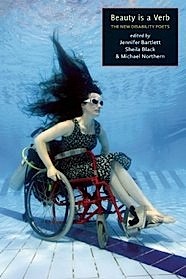
Beauty Is a Verb: The New Poetry of Disability
introductions & table of contents

edited by Jennifer Bartlett, Michael Northen, Sheila Black — from Cinco Puntos Press
This anthology makes a compelling case for rethinking postwar poetic practice in/through/by the frame of disability.
pdf:
table of contents
Preface, Jennifer Bartlett
“A Short History of American Disability Poetry,” Michael Northen
from Bartlett's intro:
For me, the idea for Beauty is a Verb can be pinpointed to one single moment, December 10, 2005, the day Norma Cole read at the Bowery Poetry Club for the Segue Reading Series. A few years earlier, after a stroke, Cole lost and regained her ability to speak. Now, she used her temporary aphasia and slurred speech to compose a poem that noted a list of words she could no longer enunciate. The result of her reading this work was alternately hilarious and devastating. Cole laughed at the ridiculous, yet utterly wrenching, situation of a poet losing words, and the audience laughed with her. Yet, it wasn’t as simple as that. Although the audience laughed, they were also visibly uncomfortable. From the sophistication of Cole’s work and her genius as a person, one can guess that this was no accident. Can an entire anthology be sparked by one reading of one poet; I am sure crazier things have happened in this world we called poetry.
After, I began to consider a series of questions. What did it mean to have a disability poetics? What was the history of the movement? What about poets, much like myself, who have a disability, but do not align themselves with identity poetry or the disability poetics movement? How do they fit into such a context, if at all?
from Northen's introduction:
In 1983, a brief article appeared in Kaleidoscope in which A. J. Baird, a scholar of medieval literature, condemned the current poetry written about disability as super-sentimental, self-pitying and eliciting superficial sympathy, a poetry that failed to rise to acceptable artistic
standards and was deservedly ignored by mainstream literature. He put out a call for poetry about physical disability that was tough-minded and grounded in concrete, physical fact. The result was Towards Solomon’s Mountain, published in 1986. While few of the writers in that volume went on to produce major collections, Baird’s collection showed what disability poetry could be. It would not be an exaggeration to call the publication of Towards Solomon’s Mountain the birth of disability poetry as a genre. Of course, the writers in Baird’s anthology were not the first American poets with disabilities to be published. Josephine Miles, Larry Eigner and Vassar Miller all had success with their writing, but had said little about their own bodies in their work. Because of this, Miles and Eigner, though known in literary circles, were overlooked by the first anthologies of disability writing.
......
The volume you hold in your hand, Beauty is a Verb: The New Poetry of Disability, is an important step in helping to transform disability poetry from marginalia into part of the American text. The time is right for it. By scanning this anthology, noting the writers included, copying a poem that especially strikes you or observing the way the writers dialogue with each other in their essays by reference to each other’s work, you are already making your own contribution to this transformation.
Many fresh faces are coming onto the American disability poetry scene. Among those are writers like Ona Gritz, Paul Guest, Laurie Lambeth, Daniel Simpson, Linda Cronin, Anne Kaier, Marie Kane and Liz Whiteacre, and Kathi Wolfe. Just as the Harlem Renaissance led to the development of African American literature and the 1960s to feminist literature, we are in a seminal period for the genre of disability literature. One day, perhaps, our children or grandchildren will look back at this decade, studying it in literature classes in the same way that we view the emergence of those other genres. It is an exciting time, and we have a chance to be in on the ground floor.